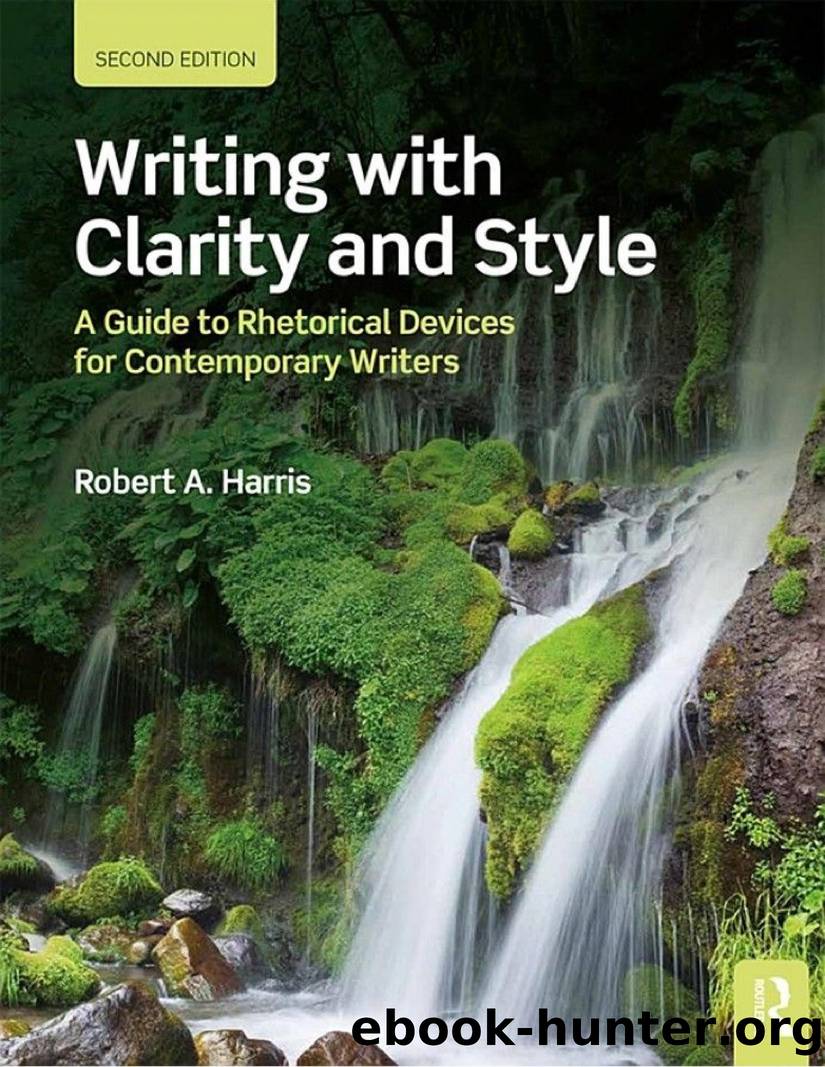Writing With Clarity and Style: A Guide to Rhetorical Devices for Contemporary Writers by Robert A. Harris

Author:Robert A. Harris
Language: eng
Format: mobi
Tags: Social Science, Research
ISBN: 9781138560093
Publisher: Routledge
Published: 2017-12-05T21:00:00+00:00
10
Figurative Language III
By these allusions a truth in the understanding is as it were reflected by the imagination; we are able to see something like color and shape in a notion and to discover a scheme of thoughts traced out upon matter.
âJoseph Addison
The proverb âThe more you know, the more you can learn,â reminds us that learn
ing is often a process of fitting new ideas into the context of our current knowledge. The figurative language devices in these Chapters ( 8 , 9 , and 10 ) enable you to construct associations (or bridges from the familiar to the unfamiliar) that can facilitate your readersâ learning process as well as provide aesthetic and imaginative qualities. Thus, these are tools of practical art.
Since this is the last chapter on figurative language, let me make one final comment about these devices. Iâve stressed repeatedly how using the right rhetorical device in the right place can provide focus, emphasis, and so forth. One thing I donât believe Iâve mentioned yet is enjoyment. Yes, why strive for cold focus, bald emphasis, and so forth when you might write in a way that your readers could actually enjoy? Readers who enjoy your writing, I am convinced, are much more likely to be persuaded by it. And they might just want to read something else youâve written.
Allusion
An allusion (uh LOO zhun) is a short, informal reference to a famous person or event. The allusion often functions as a brief analogy or example to highlight a point being made.
Plan ahead: It wasnât raining when Noah built the ark. âRichard Cushing I think we should do some more risk analysis on this âgood idea.â After all, Napoleon thought it was a good idea to march on Moscow in the middle of winter.
Allusions are most often drawn from history, Greek and Roman mythology, Shakespeare, the Bible, and literature. Years ago, educated readers were assumed to be familiar with all these areas, so allusions drawn from them (Pearl Harbor, Sisyphus, Polonius, Job, Gargantua, etc.) would have been familiar, also. Today, however, this knowledge can no longer be assumed, making the construction of allusions more challenging. To be effective, an allusion must have the following qualities:
⦠Familiarity. Consider what will be familiar to your particular audience. Teenagers may not know Greek mythology, and retirees may not know those who are famous in popular music, for example. If you are writing to a general audience that might include both teens and older people, you will have to find allusions that all members of the audience are likely to know.
⦠Endurance. Consider how long you want your writing to remain accessible to your readers. If you choose an allusion to a current celebrity, the reference might be familiar for only a few years because most celebrities fade and disappear so quickly.
⦠Focused attribute. The historical event or person must possess an attribute relevant to your reference. Some famous people are known for more than one attribute, so you might have to take care to specify which attribute you have in mind.
Download
This site does not store any files on its server. We only index and link to content provided by other sites. Please contact the content providers to delete copyright contents if any and email us, we'll remove relevant links or contents immediately.
Zero to IPO: Over $1 Trillion of Actionable Advice from the World's Most Successful Entrepreneurs by Frederic Kerrest(4307)
Machine Learning at Scale with H2O by Gregory Keys | David Whiting(4197)
Never by Ken Follett(3799)
Harry Potter and the Goblet Of Fire by J.K. Rowling(3776)
Ogilvy on Advertising by David Ogilvy(3517)
Shadow of Night by Deborah Harkness(3308)
The Man Who Died Twice by Richard Osman(2998)
Book of Life by Deborah Harkness(2869)
The Tipping Point by Malcolm Gladwell(2829)
Will by Will Smith(2795)
0041152001443424520 .pdf by Unknown(2785)
My Brilliant Friend by Elena Ferrante(2776)
How Proust Can Change Your Life by Alain De Botton(2746)
Purple Hibiscus by Chimamanda Ngozi Adichie(2654)
How to Pay Zero Taxes, 2018 by Jeff A. Schnepper(2603)
Hooked: A Dark, Contemporary Romance (Never After Series) by Emily McIntire(2502)
Rationality by Steven Pinker(2291)
Borders by unknow(2232)
Can't Hurt Me: Master Your Mind and Defy the Odds - Clean Edition by David Goggins(2230)
